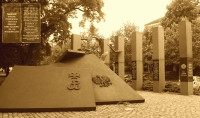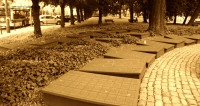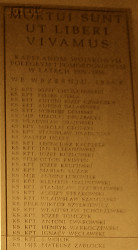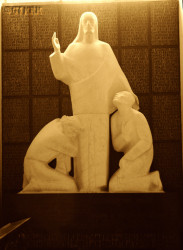Roman Catholic
St Sigismund parish
05-507 Słomczyn
85 Wiślana Str.
Konstancin deanery
Warsaw archdiocese, Poland
full list:
displayClick to display full list

searchClick to search full list by categories
wyświetlKliknij by wyświetlić pełną listę po polsku

szukajKliknij by przeszukać listę wg kategorii po polsku

Martyrology of the clergy — Poland
XX century (1914 – 1989)
personal data
surname
WĘCŁAWSKI
forename(s)
Ignatius (pl. Ignacy)
function
diocesan priest
creed
Latin (Roman Catholic) Church RCmore on
en.wikipedia.org
[access: 2014.09.21]
diocese / province
Gniezno and Poznań archdiocese (aeque principaliter)more on
www.archpoznan.pl
[access: 2012.11.23]
RC Military Ordinariate of Polandmore on
en.wikipedia.org
[access: 2014.12.20]
date and place
of death
30.01.1940

Skierniewicetoday: Skierniewice city pov., Łódź voiv., Poland
more on
en.wikipedia.org
[access: 2021.12.18]
details of death
After the abdication on 09.11.1918 of the German Emperor William II Hohenzollern; after the signing on 11.11.1918 by the Allies and the Germans, in the staff wagon in Compiègne, at the headquarters of French Marshal Ferdinand Foch, of the armistice and ceasefire — which de facto meant the end of World War I; and also after the handover on 11.11.1918 by the Regency Council – operating in the so‐called Germ. Königreich Polen (Eng. Polish Kingdom) occupied by the Central Powers (Germany and Austria–Hungary) — of supreme command over the army to Brigadier Joseph Piłsudski and his appointment as Commander‐in‐Chief of the Polish Army, which de facto meant the rebirth of the Polish state, encompassing however only the Germ. Königreich Polen, i.e. the Polish territory under Russian rule until 1915, but excluding the lands of the Prussian partition; Greater Poland — as the Prussian Germ. Provinz Posen (Eng. Poznań Province) — was still formally part of the German state. His Przemęt parish belonged to the Germ. Kreis Bomst (Eng. County of Babimost), a county located to the west of the Germ. Provinz Posen. On 20.11.1918, at a meeting in Przemęt, a 7‐person People's Council RL was elected for the Przemęt district, encompassing three neighbouring parishes, and its chairman becami his parish priest, Fr Joseph Zalewski. RL was established at the appeal of the Supreme People's Council NRL from Poznań, which had its roots in the Polish clandestine Inter‐Party Committee, operating in the last years of the German Empire, which recognized the Polish National Committee from Paris as the representative of Poland, which during the ongoing war was an act of treason. The establishment of the RL did not, of course, mean a full takeover of power — the Germans responded, among other things, by organizing units of the Germ. Grenzschutz Ost (Eng. Eastern Border Guard), a paramilitary, terrorist, volunteer formation, militarily opposing the separation of the eastern territories from Germany. Conflict was inevitable and on 27.12.1918 the Greater Poland Uprising broke out in Poznań. In Przemęt, the Poles took power peacefully, and on 06.01.1920, an insurgent unit was formed in the town square — the Przemęt Company. Fights for the villages belonging to the Przemęt district began. A month later, the enlarged Przemęt Company took an oath of allegiance to Poland in the church in Przemęt and most of it, of which became the chaplain, set off for the town of Kaszczor, with a German majority. Kaszczor was captured and the insurgents composed the Company's song, of which one of lines was „Father Węcławski goes out into the field, / To be with his faithful, / To think about salutary things / at such a momentous time”.
The Uprising ended on 16.02.1919 with the armistice in Trier, enforced by the victorious Entente states, under which the Polish insurgent Greater Poland Army was recognised as an allied army and a border was set, which „German troops were forbidden to cross”, leaving a large part of Greater Poland outside their influence. However, it was not until the Treaty of Versailles, concluded on 28.06.1919, that Greater Poland was awarded to Poland. It formally joined it on 10.01.1920, after the ratification of the treaty by all parties. Sources indicate that after the armistice in Trier, „held the position of chaplain in technical units (sappers, pilots, radio operators)” — this probably means that became the chaplain of the so‐called Technical Troops Inspection of the insurgent Greater Poland Army. In turn, in 07.1919, after the Treaty of Versailles, probably became chaplain of the 12th Greater Poland Rifle Regiment, which until 01.1920 — i.e. the entry into force of the Treaty of Versailles — manned the Polish–German demarcation line.
On 25.01.1920, the Regiment, already formally part of the Polish Army — on 01.02.1920 renamed as the 70th Infantry Regiment — set off to the Lithuanian–Belarusian Front of the Polish–Russian War of 1919‐1921. Till 04.1920 was stationed near Lida in the reserve of the Commander‐in‐Chief. On 16.04.1920 set off to the front, then established along the natural barrier formed by the rivers of Dvina in the north and Berezina. From 26.03.1920 took part in clashes with the Russians n. Borisov on the Berezina. Was there when the first Russian offensive began on c. 14.05.1920. Fought, among others, in at Ihumen, Zamostoche and Budslaw, protecting the access to Minsk. When the great Russian northern offensive under the command of General Mikhail Tukhachevsky began on 04.07.1920, for a few days defended the line of lakes connecting the upper Berezina with the Dvina, i.e. at the Ustye farm, counterattacking on Borove. After the line was broken through by the Russians, began to retreat. In constant clashes with the advancing Russians, for a few days each time putting up greater resistance on a new, encountered line of defence — the line of the Vilia River, line of former German trenches from World War I, the line of the Neman River, when on 14‐17.07.1920 took part in the Battle of Lida, on 05‐07.08.1920 reached Białobrzegi in the district of Sokołów Podlaski on the Bug River, where executed a daring counterattack that stopped the Russian onslaught. From there the Regiment was transferred to Modlin near Warsaw, occupying the Narew River line near the village of Dębe. As early as 15.08.1920 moved north, towards Nasielsk — the great Battle of Warsaw (known as the „Miracle on the Vistula”) was beginning, the decisive maneuver of which was the push of Polish troops from the Wieprz River northwards, hitting the southern flank of the attacking Russians. One of the most important battles was the Battle of Nasielsk, which ended on 16.08.1920 with the recapture of the city. From there the Regiment moved further north, after c. 30 km fighting on 19.08.1920 a bloody battle near Przemiarów, and on 23.08.1920, after another 60 km, a battle near Chorzele, forcing the Russians to flee and be interned in German East Prussia. The Regiment was then transferred to Łomża, and from there to the Suwałki region, from where it protected the Polish troops pushing the Russians eastward from the north, against the Lithuanians. In 12.1920, the Regiment returned to Poznań.
Transferred then to the reserve of the Polish Army. In 1923, 1924, 1925, 1927 and 1929 re‐appointed chaplain of the reserve of the Polish Army (from 25.11.1926 each time for a statutory period of 2 years).
After German invasion of Poland on 01.09.1939 (Russians invaded Poland 17 days later) and start of the World War II wounded in 09.1939 from a bomb shrapnel — the largest battle of the Polish defensive campaign of 1939, the Battle of Bzura, took place in the area.
Prob. joined his parishioners in a convoy of thousands escapees attempting to move east with withdrawing Polish troops.
Perished in a hospital.
cause of death
shelling (bombardment)
perpetrators
Germans
sites and events
Air raids 1939Click to display the description, Ribbentrop‐MolotovClick to display the description, Pius XI's encyclicalsClick to display the description, Greater Poland UprisingClick to display the description
date and place
of birth
10.07.1893Birth certification on:
photos.szukajwarchiwach.gov.pl
[access: 2025.08.19]

Poznańtoday: Poznań city pov., Greater Poland voiv., Poland
more on
en.wikipedia.org
[access: 2021.07.18]
parents
WĘCŁAWSKI Francis
🞲 ?, ? — 🕆 ?, ?

WĘCŁAWSKA Cecilia
🞲 ?, ? — 🕆 ?, ?
presbyter (holy orders)
ordination
13.02.1916

Gnieznotoday: Gniezno urban gm., Gniezno pov., Greater Poland voiv., Poland
more on
en.wikipedia.org
[access: 2021.12.18]
Assumption of the Blessed Virgin Mary RC archcathedral churchmore on
en.wikipedia.org
[access: 2025.03.14]
positions held
1931 – 1940
administrator — Krzycko Małetoday: Święciechowa gm., Leszno pov., Greater Poland voiv., Poland
more on
en.wikipedia.org
[access: 2021.12.18] ⋄ Blessed Virgin Mary of the Snow RC parish ⋄ Lesznotoday: Leszno city pov., Greater Poland voiv., Poland
more on
en.wikipedia.org
[access: 2021.07.18] RC deanery
c. 1935 – c. 1939
visitor / inspector of religion education — primary schools — for Leszno cou. / Włoszakowice reg.
1923 – 1931
prefect — Rawicztoday: Rawicz gm., Rawicz pov., Greater Poland voiv., Poland
more on
en.wikipedia.org
[access: 2021.07.15] ⋄ State Gymnasium ⋄ Annunciation to the Blessed Virgin Mary RC parish ⋄ Krobiatoday: Krobia gm., Gostyń pov., Greater Poland voiv., Poland
more on
en.wikipedia.org
[access: 2021.07.18] RC deanery
chaplain — Rawicztoday: Rawicz gm., Rawicz pov., Greater Poland voiv., Poland
more on
en.wikipedia.org
[access: 2021.07.15] ⋄ Polish Scouting Association ZHP — also: scoutmaster of the squad
1921 – 1923
vicar — Poznańtoday: Poznań city pov., Greater Poland voiv., Poland
more on
en.wikipedia.org
[access: 2021.07.18] ⋄ St Martin the Bishop and Confessor RC parish ⋄ Poznańtoday: Poznań city pov., Greater Poland voiv., Poland
more on
en.wikipedia.org
[access: 2021.07.18] RC deanery
1920 – c. 1921
RC military chaplain — 70th Infantry Regiment, Polish Armed Forces — formally accepted into the Polish Army as a chaplain by L. 2238 decree of the Commander‐in‐Chief of 30.07.1920
1919 – 1920
RC military chaplain — Greater Poland Army (i.e. Polish Armed Forces in the former Prussian Partition), Polish Armed Forces — i.e. 07.1919‐01.1920 of the 12th Greater Poland Rifle Regiment; 02‐07.1919 prob. of the Technical Troops Inspection; 01‐02.1919 of the Przemęt Company
1916 – c. 1919
vicar — Przemęttoday: Przemęt gm., Wolsztyn pov., Greater Poland voiv., Poland
more on
en.wikipedia.org
[access: 2021.04.02] ⋄ St John the Baptist RC parish ⋄ Śmigieltoday: Śmigiel gm., Kościan pov., Greater Poland voiv., Poland
more on
en.wikipedia.org
[access: 2021.07.18] RC deanery — also: football player of the Warta Poznań Sports Club; activist of the Association of Polish Sports Societies in the German Reich; football referee
till 1916
student — Gnieznotoday: Gniezno urban gm., Gniezno pov., Greater Poland voiv., Poland
more on
en.wikipedia.org
[access: 2021.12.18] ⋄ philosophy and theology, Archbishop's Practical Theological Seminary (Lat. Seminarium Clericorum Practicum)
student — Poznańtoday: Poznań city pov., Greater Poland voiv., Poland
more on
en.wikipedia.org
[access: 2021.07.18] ⋄ philosophy and theology, Archbishop's Theological Seminary (Collegium Leoninum)
sites and events
descriptions
Air raids 1939: During invasion of Poland commenced on 01.09.1939 Germans systematically attacked civilian targets. Many cities (Wieluń, Frampol, Warszawa, Lwów, Łomża, Puck, etc.) were bombed during air raids and totally destroyed. The hospitals and churches, visibly marked as such, were not spared. German planes also attacked columns of fleeing people on the roads, massacring them. It is estimated that c. 150,000‐200,000 civilians were killed or murdered by the Germans in 09.1939. (more on: en.wikipedia.orgClick to attempt to display webpage
[access: 2015.04.18])
Ribbentrop‐Molotov: Genocidal Russian‐German alliance pact between Russian leader Joseph Stalin and German leader Adolf Hitler signed on 23.08.1939 in Moscow by respective foreign ministers, Mr. Vyacheslav Molotov for Russia and Joachim von Ribbentrop for Germany. The pact sanctioned and was the direct cause of joint Russian and German invasion of Poland and the outbreak of the World War II in 09.1939. In a political sense, the pact was an attempt to restore the status quo ante before 1914, with one exception, namely the „commercial” exchange of the so‐called „Kingdom of Poland”, which in 1914 was part of the Russian Empire, fore Eastern Galicia (today's western Ukraine), in 1914 belonging to the Austro‐Hungarian Empire. Galicia, including Lviv, was to be taken over by the Russians, the „Kingdom of Poland” — under the name of the General Governorate — Germany. The resultant „war was one of the greatest calamities and dramas of humanity in history, for two atheistic and anti‐Christian ideologies — national and international socialism — rejected God and His fifth Decalogue commandment: Thou shall not kill!” (Abp Stanislav Gądecki, 01.09.2019). The decisions taken — backed up by the betrayal of the formal allies of Poland, France and Germany, which on 12.09.1939, at a joint conference in Abbeville, decided not to provide aid to attacked Poland and not to take military action against Germany (a clear breach of treaty obligations with Poland) — were on 28.09.1939 slightly altered and made more precise when a treaty on „German‐Russian boundaries and friendship” was agreed by the same murderous signatories. One of its findings was establishment of spheres of influence in Central and Eastern Europe and in consequence IV partition of Poland. In one of its secret annexes agreed, that: „the Signatories will not tolerate on its respective territories any Polish propaganda that affects the territory of the other Side. On their respective territories they will suppress all such propaganda and inform each other of the measures taken to accomplish it”. The agreements resulted in a series of meeting between two genocidal organization representing both sides — German Gestapo and Russian NKVD when coordination of efforts to exterminate Polish intelligentsia and Polish leading classes (in Germany called «Intelligenzaktion», in Russia took the form of Katyń massacres) where discussed. Resulted in deaths of hundreds of thousands of Polish intelligentsia, including thousands of priests presented here, and tens of millions of ordinary people,. The results of this Russian‐German pact lasted till 1989 and are still in evidence even today. (more on: en.wikipedia.orgClick to attempt to display webpage
[access: 2015.09.30])
Pius XI's encyclicals: Facing the creation of two totalitarian systems in Europe, which seemed to compete with each other, though there were more similarities than contradictions between them, Pope Pius XI issued in 03.1937 (within 5 days) two encyclicals. In the „Mit brennender Sorge” (Eng. „With Burning Concern”) published on 14.03.1938, condemned the national socialism prevailing in Germany. The Pope wrote: „Whoever, following the old Germanic‐pre‐Christian beliefs, puts various impersonal fate in the place of a personal God, denies the wisdom of God and Providence […], whoever exalts earthly values: race or nation, or state, or state system, representatives of state power or other fundamental values of human society, […] and makes them the highest standard of all values, including religious ones, and idolizes them, this one […] is far from true faith in God and from a worldview corresponding to such faith”. On 19.03.1937, published „Divini Redemptoris” (Eng. „Divine Redeemer”), in which criticized Russian communism, dialectical materialism and the class struggle theory. The Pope wrote: „Communism deprives man of freedom, and therefore the spiritual basis of all life norms. It deprives the human person of all his dignity and any moral support with which he could resist the onslaught of blind passions […] This is the new gospel that Bolshevik and godless communism preaches as a message of salvation and redemption of humanity”… Pius XI demanded that the established human law be subjected to the natural law of God , recommended the implementation of the ideal of a Christian state and society, and called on Catholics to resist. Two years later, National Socialist Germany and Communist Russia came together and started World War II. (more on: www.vatican.vaClick to attempt to display webpage
[access: 2023.05.28], www.vatican.vaClick to attempt to display webpage
[access: 2023.05.28])
Greater Poland Uprising: Military insurrection of Poles of former German Germ. Posen Provinz (Eng. Poznań province) launched against German Reich in 1918‐1919 — after the abdication on 09.11.1918 of the German Emperor William II Hohenzollern; after the armistice between the Allies and Germany signed on 11.1.1918 in the HQ wagon in Compiègne, the headquarters of Marshal of France Ferdinand Foch — which de facto meant the end of World War I — against the German Weimar Republic, established on the ruins of the German Empire, aiming to incorporate lands captured by Prussia during partitions of Poland in XVIII century into Poland. The Republic of Poland, reborn on 11.11.1918, initially formally included only the so‐called Germ. Königreich Polen (Eng. Kingdom of Poland), i.e. the territory that had been under Russian rule until 1915 and then under the control of Central States (Germany and Austria–Hungary), but did not include the Prussian partition. Started on 27.12.1918 in Poznań and ended on 16.02.1919 with the armistice pact in Trier, forced by the victorious Entente states, which included provisions ordering Germany to cease operations against Poland and, importantly, recognizing the Polish insurgent Greater Poland Army as an allied armed force of the Entente. De facto it turned out to be a Polish victory, confirmed in the main peace treaty after World War I, the Treaty of Versailles of 28.06.1919, which came into force on 10.01.1920 and in which most of the lands of the Prussian partition were recognized as Polish. Many Polish priests took part in the Uprising, both as chaplains of the insurgents units and members and leaders of the Polish agencies and councils set up in the areas covered by the Uprising. In 1939 after German invasion of Poland and start of the World War II those priests were particularly persecuted by the Germans and majority of them were murdered. (more on: en.wikipedia.orgClick to attempt to display webpage
[access: 2016.08.14])
sources
personal:
www.wtg-gniazdo.orgClick to attempt to display webpage
[access: 2012.11.23], wloszakowice.plClick to attempt to display webpage
[access: 2016.08.14], photos.szukajwarchiwach.gov.plClick to attempt to display webpage
[access: 2025.08.19]
original images:
baza.rocznikpilkarski.plClick to attempt to display webpage
[access: 2024.12.13], www.wbc.poznan.plClick to attempt to display webpage
[access: 2016.08.14], www.parafiakrzycko.plClick to attempt to display webpage
[access: 2016.08.14], www.katedrapolowa.plClick to attempt to display webpage
[access: 2014.01.16]
LETTER to CUSTODIAN/ADMINISTRATOR
If you have an Email client on your communicator/computer — such as Mozilla Thunderbird, Windows Mail or Microsoft Outlook, described at WikipediaPatrz:
en.wikipedia.org, among others — try the link below, please:
LETTER to CUSTODIAN/ADMINISTRATORClick and try to call your own Email client
If however you do not run such a client or the above link is not active please send an email to the Custodian/Administrator using your account — in your customary email/correspondence engine — at the following address:

giving the following as the subject:
MARTYROLOGY: WĘCŁAWSKI Ignatius
To return to the biography press below:
 Click to return to biography
Click to return to biography

















